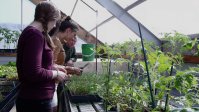Sustainability Across the Curriculum
Using a campus greenhouse, teachers in multiple disciplines collaborated to make connections to sustainability.
Your content has been saved!
Go to My Saved Content.Overview
Integrated Studies: Sustainability and Cross-Curricular Connections
Montpelier High School uses the concept of sustainability to make curriculum connections across a wide variety of disciplines at the school, from students studying nutrient cycles in biology class, to learning about sustainability through the lens of economics, or even looking at how energy is sustainable in physics class.
Teachers find that these cross-disciplinary connections enhance student understanding, and therefore they encourage learning across disciplines. The concept of sustainability is visible in a concrete context via the school's greenhouse and food production model. Every student can understand sustainability from many perspectives and content areas. These cross-curricular connections provide for a richer, deeper learning experience for all students.
At MHS, the concept of sustainability is considered both important content to teach (by looking at the economic, social, and environmental angles) and an approach to teaching itself. The school built a greenhouse about ten years ago, and has been using it as an outdoor classroom with a focus on sustainability and food production.
Getting Started
Initially, teachers came together on a voluntary basis to explore the idea of sustainability and how they might incorporate it into their classes. Tom Sabo, a science teacher who's been at the school for almost 20 years, sent an email to see who was interested in having a conversation around using the concept of sustainability to make cross-disciplinary connections. About a dozen teachers showed up after school and began to talk about how to tie the concept into their curriculum. They decided that they wanted to make it a thread through their classes while also making the school itself a model of sustainability. What could they do on the campus to really model sustainability? The idea of food production came up pretty quickly, and they decided to explore building a greenhouse as an outdoor classroom.
The Greenhouse: A Big Idea
The school started off with a big vision -- an on-campus greenhouse. The first step was approaching the district for permission to build the greenhouse on school property. Once that was resolved, the school started raising grant money from both local and national funders.
The first grant was just a few hundred dollars from a local organization, but it was enough to get started. Most of the grants that came in were initially around environmental issues like dealing with our carbon footprint, or nutrition grants that addressed issues of teen obesity and diabetes. Later money came from educational organizations interested in things like service learning because it offered a great way to engage students. Grant funds mainly provided the money to build the greenhouse, and any other facilities like the hoop house. Over time the school proved that there was value in the greenhouse and sustainability approach, and the district also became a core supporter.
Daily operations of the greenhouse are actually paid for by the sale of the produce, which is sold at a discount to the food services department. The money the school makes from the produce is then used to purchase seeds, soil, and supplies for the greenhouse.
A cheaper and easier alternative to building a greenhouse could be to start with a hoop house, which is a nonpermanent structure. Hoop houses, which can be used to also grow a variety of crops, are easy to put up and take down. MHS currently supports both a greenhouse and a hoop house for additional crops.
Cross-Curricular Examples: Sustainability
Biology class is really at the center of tying sustainability to subject content. Every biology student learns about nutrient cycles, plant physiology, and anatomy, as well as units on the biosphere, energy transfer, and recycling nutrients. The greenhouse gives students an additional context for applying their learning, as everyone in biology class helps to produce the salad greens for the cafeteria.
In economics class, a teacher presented a unit about small banks and wealth creation and extraction. Another year, students looked at the cost-benefit analysis of the greenhouse expenses and the crops they grew.
In physics class, a teacher had the students do a feasibility study to see how much energy the greenhouse used, and whether the solar panels produced enough energy to meet the needs of the space.
In the environment applications class, students look at a range of sustainability issues including population, waste management, climate change, ozone depletion, and water runoff. They also get the outdoor gardens started, test the soil, and set up management and harvest plans for the next year's class to follow.
Professional Development for Teachers: Making Connections
The district has seen an increased interest in the work of MHS and the success of its greenhouse and sustainability focus. Professional development is now offered to all teachers interested in learning about sustainability and thinking about how they can make cross-disciplinary connections in their own classroom. The class is taught by MHS science teacher, Tom Sabo. It's a ten-week course, and teachers can also receive a recertification credit and a graduate credit from a local college when they complete the course. The course focuses on a food systems approach, and how to make those curriculum connections.
